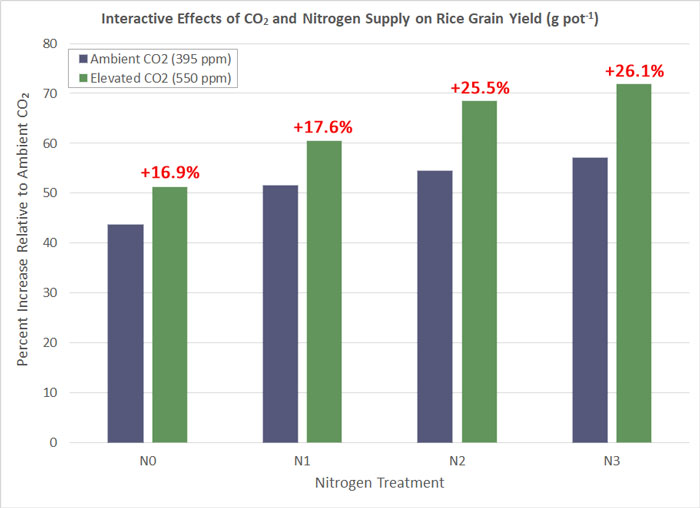| Tweet | Follow @co2science |
Paper Reviewed
Raj, A., Chakrabarti, B., Pathak, H., Singh, S.D., Mina, U. and Purakayastha, T.J. 2019. Growth, yield and nitrogen uptake in rice crop grown under elevated carbon dioxide and different doses of nitrogen fertilizer. Indian Journal of Experimental Biology 57: 181-187.
Recognizing the beneficial impacts of the increasing concentration of atmospheric carbon dioxide on crop growth, Raj et al. (2019) set out to study the interaction between elevated CO2 and nitrogen supply. In doing so, the six Indian researchers grew rice (Oryza sativa, cv. Pusa 44) in pots in a free-air CO2 enrichment (FACE) facility at the Indian Agricultural Research Institute in New Delhi, India under ambient (395 ppm) or elevated (550 ppm) CO2 and four levels of nitrogen supply (no nitrogen, 0.6 g pot-1, 0.8 g pot-1 or 1.0 g pot-1, of which the latter 3 levels of nitrogen supply corresponded to 75%, 100% and 125% of the recommended dose, respectively).
Results of the analysis revealed that both elevated CO2 and increased nitrogen supply had a positive impact on various rice growth-related parameters, including plant height, number of tillers, panicle length, number of panicles, number of grains per panicle, root biomass, aboveground biomass and grain yield. With respect to grain yield, this key parameter increased by 16.9%, 17.6%, 25.5% and 26.1% under elevated CO2 in the 0, 0.6, 0.8 and 1.0 g pot-1 nitrogen treatments, respectively.
Raj et al. also report that the grain and straw nitrogen concentration decreased under elevated CO2, albeit the nitrogen content and nitrogen use efficiency increased. However, the reduced nitrogen concentration under elevated CO2 diminished as the nitrogen supply increased, leading the authors to conclude that in order "to maintain plant nitrogen concentration, [the] application of [an] additional dose of nitrogen is required." All in all, therefore, the future looks bright for those who grow and consume rice!

Figure 1. Interactive effects of elevated CO2 and nitrogen supply on rice grain yield. Nitrogen supply treatments include (1) N0 = no nitrogen supply, (2) N1 = 0.6 g pot-1, (3) N2 = 0.8 g pot-1 and (4) N3 = 1.0 g pot-1. The percentages shown in red indicate the percent increase in grain yield due to elevated CO2 (relative to ambient CO2) for a given nitrogen supply treatment. Data used in the creation of this figure come from the author's Table 2.




